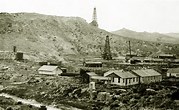 photo courtesy of wyomingtailsandtrails.com
photo courtesy of wyomingtailsandtrails.com
Dave Walsh 18 Dec ’15
It’s nine miles long and five miles wide. Now that’s a lot of Black Gold. It was 135 years ago that the first traces were seen in creek bottoms by stockmen running cattle just north of Casper, Wyoming, in the Midwest-Edgerton area. The small seeps were used to grease wagon axles. Little did anyone know back then that they were treading above a huge underground pool of oil.
The first claims were filed in 1883, and four years later, the first well was drilled, and oil was taken from the ground at a rate of 60 barrels a day. Then in 1908, the first big gusher, said to have shot over a thousand feet in the air, was brought in. And the Wyoming Wonder known as the Salt Creek Oil Field had hit the motherlode.
The dark crude had to be hauled to Casper, 40 miles south, in horse-drawn tanks until 1910 when the first pipeline was laid between the Salt Creek Oil Field and the Casper refineries. There were many big strikes to come at Salt Creek, and by the 1920’s it grew to the largest light oil field in the world, producing 35 million barrels of oil a year. When production has waned, water injection techniques have revitalized output. And to this day, wells continue to pump Black Gold at the Salt Creek Oil Field, a hard-working and productive Wonder of Wyoming.
I’m Dave Walsh, proud to live in Wyoming, and proud to tell her fascinating story.
